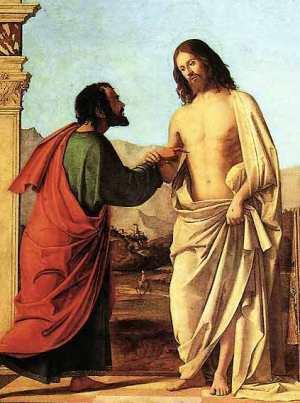
The Day
of St. Thomas, celebrated on December 21, is also the day of the
winter solstice, the year's longest night and shortest day. St.
Thomas is commemorated on this day because he was the last one of
the apostles to become convinced of Jesus' resurrection -- he was
the one who for the longest time remained in the "night of unbelief
and doubt." These are some of the traditions practiced on this day:
*
Thomasfaulpelz or Domesel (lazybone or donkey of St. Thomas
day) were names given to the last person to get out of bed and for
the last student to appear in class on that particular morning in
Westphalia. (Tradition of der fulle Thommes in Cologne, with poems)
* The Rittburgische Hochzeit (Rittberg wedding), also in
Westphalia, was an opulent meal served in the belief that if you
ate well on St. Thomas day, you could expect to do so all of the
next year.
*
The Segensfrüchte (blessed fruit) represent basically
the same idea. In southern Germany, it is hoped that when a bowl
of fruit, vegetables and nuts is placed on the table, a lack of
them in the year to come will be prevented. Exchanging gifts of
apples and nuts extended this wish to neighbors and friends.
*
Blutiger Damerl (Bavarian dialect for bloody Thomas) and
Schweinethomas (St. Thomas pig) may seem odd terms in connection
with a saint. They refer to the tradition that demanded that on
Bavarian farms, and also elsewhere, the whole family and the farmhands
sat down to an opulent meal of roasted pork on Christmas day. The
pig especially raised and fattened for this occasion was called
the "Weihnachter" (Christmas pig). It was usually slaughtered on
this day to have the meat and sausages ready by Christmas.
Trying
to steal a farmer's "Weihnachter," either alive or when it was butchered,
worked about the same way as stealing the Maypole, only stealth
and cunning were allowed, not bodily force. Very cautious owners
slept in the piggery, so that they could better guard their "Weihnachter."
Next page
> Three Kings and Epiphany
> Page 1, 2,
3, 4,
5, 6,
7, 8
|
|
